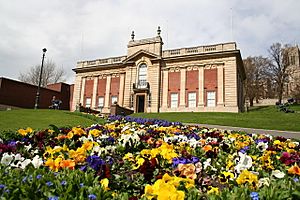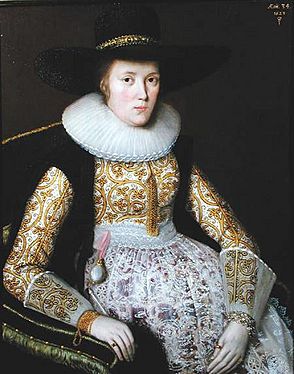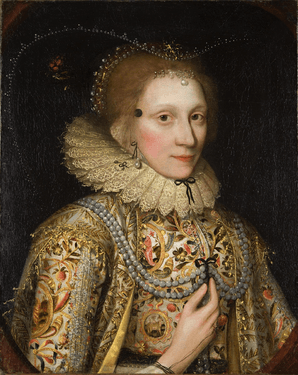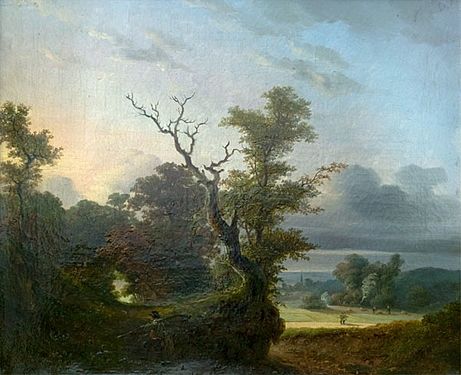Usher Gallery facts for kids
 |
|
| Established | 1927 |
|---|---|
| Location | Lincoln, England |
| Type | Art gallery |
The Usher Gallery is a cool art museum located in Lincoln, England. It's a place where you can see amazing artworks by famous painters like J. M. W. Turner and L. S. Lowry. The gallery first opened its doors in 1927 and is now part of the bigger Lincoln Museum.
Contents
History of the Usher Gallery
James Ward Usher was born in Lincoln in 1845. His father, James Usher, started a jewellery and watchmaking business in 1837. Young James joined his father's business, Usher and Son, after 1874.
James Ward Usher loved collecting beautiful things. He collected watches, fancy ceramics from places like Meissen and Sèvres, English silver, and tiny portrait miniatures. He even had an enamelled thimble case that was said to belong to the family of Charlotte Brontë.
Usher was very proud of his collections. He even got permission to use the Lincoln Imp in his work, which made his items even more popular. The Prince of Wales was once seen wearing a pin with the imp, which Usher had given him.
James Ward Usher passed away in 1921. He left a lot of money to build an art gallery. He wanted his amazing collection to be kept in a museum named after him. The gallery was designed by Reginald Blomfield and officially opened on May 25, 1927, by the Prince of Wales.
The Usher Gallery is a beautiful building made of stone and brick. It has tall, decorative columns and a fancy roofline. It sits in a small park on a hill, looking over the lower part of Lincoln. It is the only art gallery built specifically for public use in Lincolnshire. It is owned by the Lincoln City Council.
How the Gallery Developed
The Usher Gallery later joined with the City and County Museum. A museum was first planned in 1906, and Arthur Smith became its curator. Smith was a keen naturalist who collected many local items. By 1906, he had gathered thousands of objects, from ancient finds to decorative art. This collection became the heart of the museum.
Important items from Lincoln Cathedral and other local groups were brought together under one roof. Smith retired in 1935. By 1974, the Usher Gallery was also known as the county's main archaeological museum.
Modern Art and Technology
The Usher Gallery uses cool new technology like 3D scanning. This tech can capture the exact shape of an object and save it as a digital file. This helps museums manage, protect, research, and show their collections to the public.
In 2012, the gallery started using 3D printing for its modern art program. An artist named Oliver Laric suggested that 3D models of the gallery's objects could be downloaded for free. This means you can download the digital files and even 3D print them yourself! This project works for many materials, like ceramics and metal. While these 3D scans are amazing, they are not meant to replace the actual artworks.
Art Collections
The Usher Gallery has a wide variety of art and objects. You can see modern and contemporary art, portraits, landscapes, sculptures, drawings, photographs, and decorative art.
The gallery has two floors. The first floor often hosts special, temporary exhibitions. The ground floor displays items from the gallery's permanent collection. Some famous pieces include a portrait of Joseph Banks by American artist Benjamin West, views of Lincoln by L. S. Lowry, and modern works by John Piper. The sculpture collection includes a tree-ring sculpture by Edward Allington. The decorative art collection features ceramics, glass, silver, and jewellery.
-
Robert Peake the Elder, unknown lady (1623)
Donations to the Collection
Many of the artworks and objects at the Usher Gallery are there because of generous donations from people and organisations. The museum is always happy to talk about new offers of donations. The art and decorative-arts collections have grown a lot over the years thanks to gifts, special purchases, and money left in wills. Many groups and local people have helped build the collections of watches, porcelain, and miniatures.
Gallery Activities
Educational Programs
The Usher Gallery offers fun educational programs. For example, the Museum Apprentice Activity gives children aged 5–11 art workshops during school holidays or on Saturdays. The gallery staff also provide helpful resources and services. There are even special courses for children with unique learning needs and for adults.
Archaeological Archives
The museum has a long history of being involved in archaeological research. The Lincoln Archaeological Committee started studying Lincoln's early history in 1945. Many early surveys and archaeological projects are now kept at this museum. Universities, researchers, and archaeological companies use these archives.
Modern and Contemporary Art Program
In 1946, the gallery started a program to invite modern artists and curators to show their work. This includes modern British art. In 2013, contemporary artists were invited to display works from the Arts Council Collection. The next year, famous artists like Pablo Picasso, Andy Warhol, Henri Matisse, and Salvador Dalí had their work shown.
Funding and Partners
The gallery gets a lot of support from organisations that provide money and resources. The contemporary art program, for instance, received a big financial boost from the Arts Council England. Many of the permanent artworks have been bought with help from a group called the Art Fund. Academic partners, like Bishop Grosseteste University College Lincoln, also help support the gallery's educational programs. The Arts Council also helps fund the gallery's temporary collections.
Future of the Gallery
In January 2019, there were discussions about using part of the gallery for events like weddings and moving some of its collection. Some people worried this would make the art harder to see. However, after talks between the local councils, it was decided that the Usher Gallery would stay open. The agreement was changed to allow events, but Lincoln's museum and art collections will remain in Lincolnshire.
Recent Exhibitions
The Usher Gallery regularly hosts exciting exhibitions. Here are some that have taken place recently:
- Community Choice, from June 10 to October 8, 2023
- Re:Collection – featuring works by art students from the University of Lincoln, from April 29 to June 3, 2023
- David Remfry: A Moment Captured, from January 28 to May 1, 2023
- Best Art Vinyl: Album Artwork Through the Ages, from October 22, 2022, to January 22, 2023
- Usher Open Exhibitions: Art Out of Isolation, from October 1, 2022, to January 8, 2023
- Microworld: Lincoln, from July 9 to October 2, 2022
- Lincolnshire Artists' Society Summer Exhibition 2022
- Rachel Carter: Pilgrim Woman, from November 20, 2021, to January 2, 2022
- Laura Wilson, Old Salt, from May 20 to August 23, 2021




